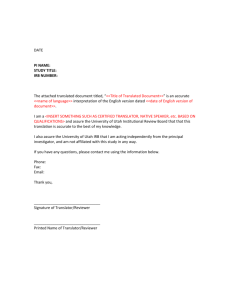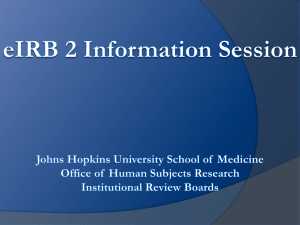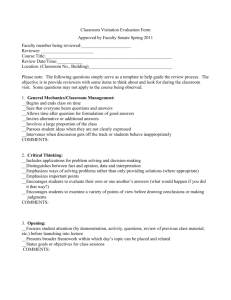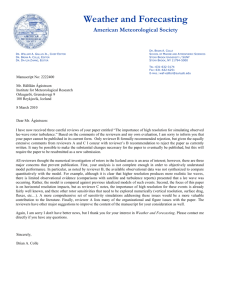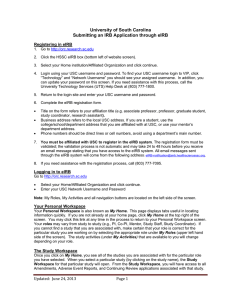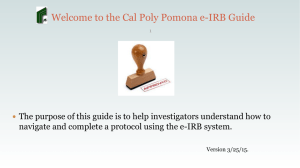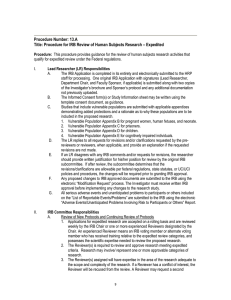training session's handout
advertisement
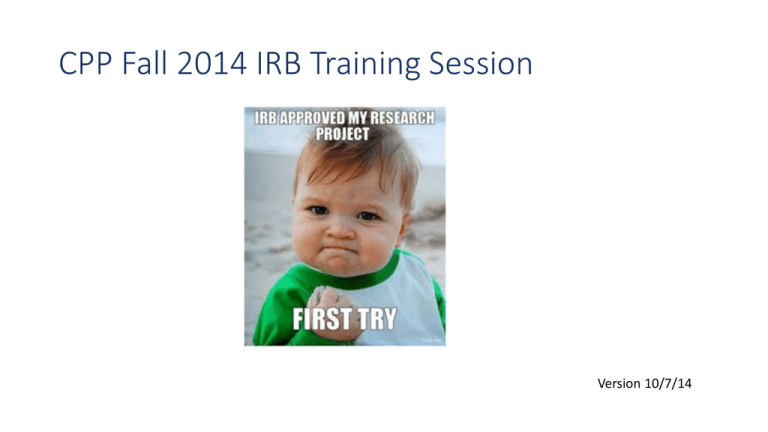
CPP Fall 2014 IRB Training Session Version 10/7/14 eIRB Instructions • To access the full eIRB instructions, please visit our website http://www.csupomona.edu/~research/irb/index.shtml • Click on the “Getting Started With a Protocol” tab. • Click on “How to Create an eIRB Protocol.” Communicating With Your Assigned Reviewer Administrative Reviewer • When communicating via email, always include your protocol number in the subject line and only use one email threat. • Be sure to address comments made by the administrative reviewer in full detail. Designated IRB Reviewer (DIR) • DIR appreciate clarity, detailed information and grammar among other things. • It is always best to write your protocol in a way that a person outside of your discipline or campus, can understand exactly what your study is about. *When revising your protocol according to the reviewers comments, please indicate the changes in BOLD OR RED. Viewing and Responding to Comments 1. Click on the “Review” option from the protocol form. 2. This window will pop-up and under each or some tabs you will find comments made by the admin reviewer of DIR. Note: Make sure that you make the appropriate changes indicated my the reviewers comments to your protocol in BOLD or Red. 3. To respond, simply click on the comment and enter your respond in the “Response” box. To save your response click “Respond.” Approved Protocol 1. Email Notification: The investigators will receive an email when their protocol has been approved. 3. Finding the Approval Memo on the E-IRB Portal: Right click on the paper clip then on the drop down menu select edit attachment. Be sure that the paper clip you are selecting is the file not the document (file is the pink bar). This window will pop-up and from here you can select the file containing the approval memo to be printed. The header should say: 5 Anonymity VS. Confidentiality: No study can be both! However, to be technical, a study may include two different modes of data collection. Anonymity Confidentiality • A “strictly anonymous” study design is one in which it is impossible to trace data or information back to the research subject from whom it was obtained. • “Confidential” research participation means that the data from the research subject(s) can potentially be identified or linked to a particular individual. • In other words, the data cannot be identified to any particular research participant, not even by the researcher. There is total separation. • Any data collected face-to-face (consumer survey, focus groups, standing in front of a classroom, etc.) is automatically considered in the category of being “confidential” as opposed to “anonymous.” • No study design that involves the creation of a code linking the subject’s identity to a pseudonym or a number can be termed an anonymous study, as the identity of the subject can be traced to the data • This is true even when the researcher assigns a coding number to the subject—and this number cannot be traced back to the subject—because the researcher him/herself knows who provided the data. Thank you! • Thank you for your patience and hard work! • Please share suggestions for improving this training guide. • The eIRB looks formidable at first, but it will make sense. Some of its best features are: -Automatic notices when your protocol is approaching expiration. - Accessibility on mobile devices. - Real-time updates about the protocol state. Once again, Thank you! Version 10/7/14. 7
